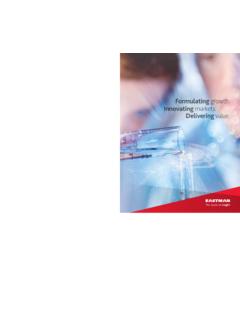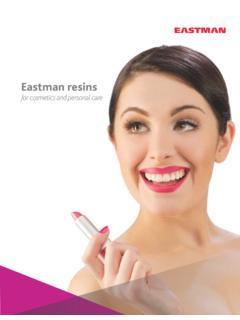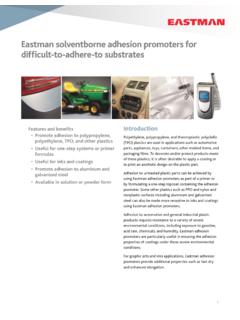Transcription of Development of Low VOC Additives to Extend the Wet Edge ...
1 Development of Low VOC Additives to Extend the Wet Edge and Open Time of Aqueous Coatings Kevin W. McCreight, Rebecca Stockl, Carlo Testa, Kab Sik Seo Eastman Chemical Company Research Laboratories One of the challenges of formulating waterborne coatings is achieving an acceptable balance of properties both during the film application and drying process as well as in the final film. This difficulty is compounded by regulations relating to the reduction of volatile organic compounds (VOCs) in architectural coatings. There is a competition between the requirements for adequate workability time of the coating with appropriate film formation and recoat behavior. The period in which irregularities in a freshly applied coating can be repaired without resulting in brush marks is referred to as the open time, while the period in which a coating can be applied over an existing paint film without leaving lap marks is deemed the wet edge time.
2 Aqueous coatings generally employ dispersed high molecular weight polymers as binders. These binders often provide short open times when the coating is dried since the dispersed polymer particles tend to be immobilized quickly in the edge region of an applied coating. As a result, the viscosity of the coating increases rapidly, which leads to a limited window of workability. Small molecule alkylene glycols such as ethylene and propylene glycol are routinely incorporated in aqueous coatings as humectants, but are limited in utility since they are considered to be VOCs. This paper describes the process by which new, low VOC Additives were developed to improve open time and wet edge in aqueous coatings. Mechanisms for the enhanced performance will be outlined through use of novel rheological techniques.
3 Paint performance properties will be exemplified in a typical architectural formulation. Background While a significant amount of literature has been published on the processes related to film formation and coalescence, there has been less focus on fundamental mechanisms related to the impact of glycols and other Additives on the workability of waterborne architectural paints. In 1974, Andrews1 studied the influence that ethylene and propylene glycol impart on the drying behavior of latex paints. He noted that although ethylene glycol is more hydrophilic than propylene glycol, it evaporates more slowly from formulated coatings. Examination of weight loss and compositional information for systems applied under a range of temperatures and relative humidities revealed that propylene glycol begins to evaporate as soon as the paint is drawn down at elevated temperature, but does not leave until about half of the original volatiles have evaporated at lower temperature.
4 Sullivan2 assessed the influence of organic solvents with a variety of partition coefficients on evaporation rates in latex paints. He concluded that more hydrophilic solvents, such as ethylene glycol, tend to partition predominantly into the aqueous phase, which allows them to diffuse out of the coating more readily than a hydrophobic coalescent, which largely partitions to the polymer. Interestingly, it was noted that ethylene glycol accelerates coalescent evaporation, and it was proposed that the glycol creates a pathway in the hydrophilic network through with the coalescent may more easily escape. Croll3 studied the drying of latex coatings, and confirmed Andrews finding that the weight loss of ethylene glycol appears to occur after the majority of the water has evaporated.
5 Croll proposed a two stage drying process in which water evaporates from the edges and surface of a drying coating at a constant rate followed by a stage in which evaporation is restricted due to changes in the wet interior of the coating. It is noted that short open times in latex paints could be linked to both the speed at which water evaporates from a coating as well as the dry layer forming on the exterior of the film. Winnick4 compared the dry time of latexes with high and low glass transition temperatures (Tg) as compared to a blend of latexes, and found that hard (high Tg) latexes dry more rapidly than soft (low Tg) latexes, while some blends of the two dry more slowly than either of the individual latexes. Hard latexes do not deform during drying, which leaves a pore structure through which water can pass. In blended systems, softer latexes can deform and fill the voids between harder particles, which hinders evaporation.
6 It was proposed that drying proceeds inward from the edge and a drying front exists at the boundary between the dried film and the wet dispersion such that water is driven to this front where evaporation can occur more readily than from the surface of the drying film as illustrated in Figure 1. The rate of propagation of this drying front may relate to open time in latex paint systems. Figure 1. Idealized mechanistic view of the drying process, adapted from Winnik4 Salamanca5 examined the lateral drying in waterborne latexes using magnetic resonance microscopy and determined that open time increased substantially above a particular reduced capillary pressure pcap, in agreement with a model published in 1998 by Routh6. Equation 1 (from Salamanca5 and Routh6) suggests that open time should increase at elevated pcap, since the recession of the water front is slower.
7 = 2075 3 (1 ) (1) In the above equation, is the surface energy of the liquid, 0 is the zero shear viscosity for the latex, E is the evaporation rate, a is the radius of the particles, m is the volume fraction solids at close packing, is the viscosity of the continuous phase, and H is the initial film thickness. Salamanca5 studied the influence of pcap on open time by varying particle radius, evaporation rate, and film thickness which led to pcap values ranging from 1 to 417. It was observed that at low pcap, water recedes from the sample edge immediately, while at high pcap, the water is pinned at the edge for about half of the drying time5. As a result, open times were found to be relatively short for pcap values below 15 while open times were substantially longer at higher values of pcap.
8 Numerous techniques to characterize open time, wet edge, and viscosity build during cure have been described in recent publications. One of the most common techniques for evaluation of open time and wet edge requires a paint film to be drawn down on a sealed chart using a 3 mil Bird bar. A series of X marks are made in the center of the drawdown in accordance with Figure 2. After fixed periods of time, paint is brushed four cycles back and forth across the film. The point at which the edge of the drawdown can no longer be worked into the body of the paint is referred to as the wet edge time, while the time at which the X begins to show through the paint is deemed the open time7,8. A similar test method is under Development by ASTM. Figure 2. Typical test method for open time and wet edge testing Monaghan described a brushed flow out test as a method to assess brush marks as a measure of paint flow out during drying7.
9 Akkerman8 and Browning9 utilized a technique termed Falling Wave Analysis by which a sinusoidal applicator is utilized to create unevenness in a wet film on a substrate that can be controlled in terms of temperature and angle of tilt during dry. Changes in amplitude are related to leveling, while wave shifts provide information on sagging, and loss of fluidity may be related to open time. Rheological measurements also provide unique insight on viscosity Development in drying films. Molenaar10 outlines the applicability of a filmviscometer where the velocity with which a steel ball rolls through a drying coating held at an angle may be related to an apparent viscosity. By measuring the velocity with time, the apparent viscosity can be determined as a function of drying time, which may be related to sag, leveling, and open time.
10 L fflath11 compared open time from a modified dry time recorder with that calculated from the point of infinite viscosity as measured by creep mode rheology using a cone and plate viscometer on coating samples collected after being dried for different times. Results indicated good correlation between open time from the rheometer and dry time recorder. Impact of VOC Regulations Over the past decade, there have been significant changes in the regulations governing the use of volatile organic compounds (VOCs) in architectural coatings. In the United States, several regulatory bodies have VOC restrictions, including SCAQMD (South Coast Air Quality Management District), OTC (Ozone Transport Commission), CARB (California Air Resources Board), and the US Environmental Protection Agency (EPA). The usage of VOCs has been, and will continue to be curtailed by these new regulations.












